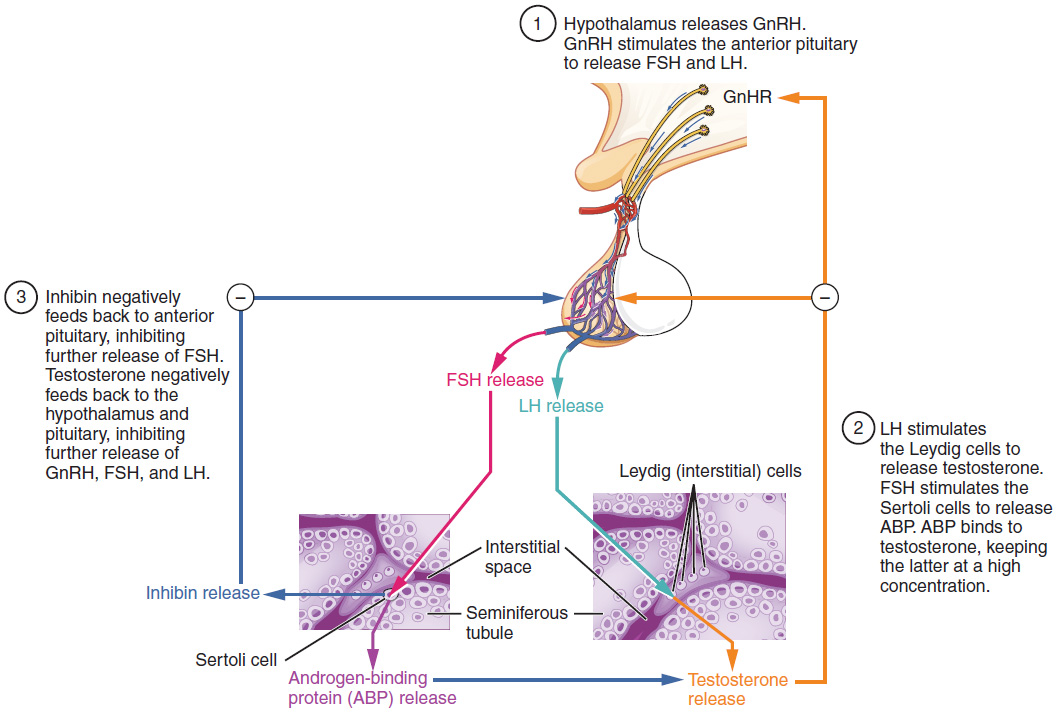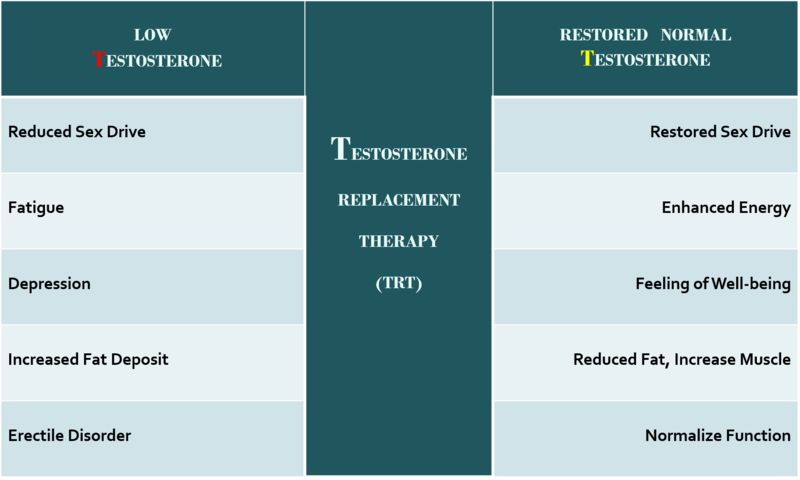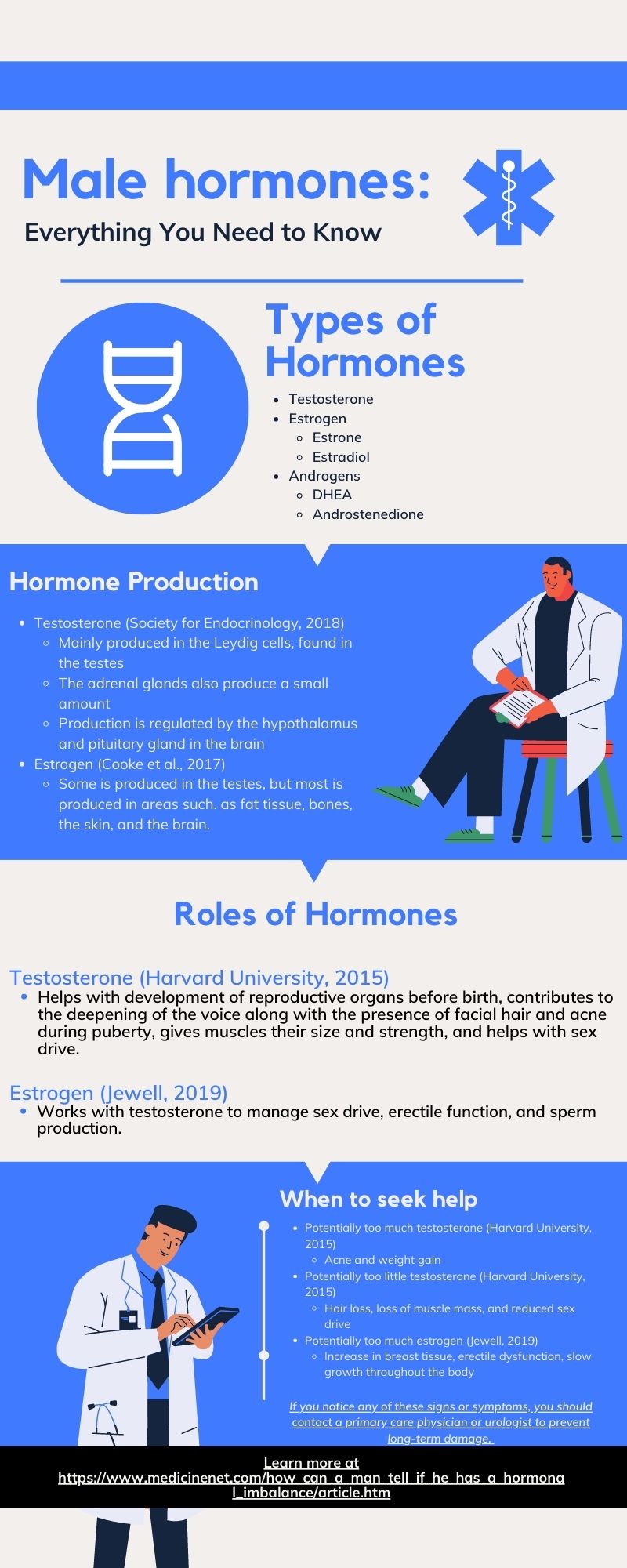5 Hormones
Hannah Fortune
Introduction
In males, there are a few different kinds of hormones. The main type that most everyone knows about is testosterone. However, males actually also have the female hormone, estrogen. The types of estrogen that men have are called estrone and estradiol (Jewell, 2019). Men also have the androgens DHEA and androstenedione (Gray et al., 2017). It is important for men to understand the roles of these hormones as they age.
Hormone Production
Testosterone is produced in a couple of different places in the body. The main place is the Leydig cells, found in the testes. The adrenal glands also produce a small amount of testosterone. Testosterone production is regulated by certain areas of the brain, the hypothalamus, and the pituitary gland. The hypothalamus releases a hormone called gonadotropin-releasing hormone, which makes the pituitary gland produce and release another hormone called luteinizing hormone (LH). Once LH enters the bloodstream, it travels to the testes and starts the production of testosterone (Society for Endocrinology, 2018). Estrogen is also produced in different places in the male body. The testes produce around 20% of a male’s total estrogen, while the rest actually comes from the conversion of testosterone in areas of the body such as fat tissue, bones, the skin, and the brain (Cooke et al., 2017).
 File:Figure 28 01 07.JPG by Wikimedia Commons is licensed under CC BY 3.0
File:Figure 28 01 07.JPG by Wikimedia Commons is licensed under CC BY 3.0
Role of Testosterone
Testosterone plays a very important role in many different ways throughout a male’s life. For instance, it helps with the development of male reproductive organs before birth, contributes to men’s voices getting deeper and the presence of facial hair and acne during puberty, it gives muscles their size and strength, and it helps with a male’s libido, or sex drive (Harvard Health Publishing Harvard Medical School, 2019). When a male has too much testosterone, it can lead to many problems. Some of these problems include low sperm count and smaller testicles, increased risk of heart attacks, liver disease, acne, weight gain, high blood pressure, and high cholesterol (Harvard Health Publishing Harvard Medical School, 2019). Not having enough testosterone leads to its own health problems which can include less hair, loss of bone density and muscle mass, low sex drive, and a low sperm count (Harvard Health Publishing Harvard Medical School, 2019). Reproductive organ problems, along with genetic diseases such as Klinefelter syndrome and hemochromatosis can cause issues with testosterone levels in a male’s body (Harvard Health Publishing Harvard Medical School, 2019).
Role of Estrogen
Interestingly enough, estrogen plays a pretty important role in the male body. Estrogen works along with testosterone to help manage sex drive, erectile function, and sperm production (Jewell, 2019). Just like with testosterone, when a male has too much or too little estrogen, health problems can occur. If a male has too much estrogen, they can experience infertility, erectile dysfunction, slow growth during puberty, an increase in breast fat tissue, and reduced sperm count. If a male does not have enough estrogen not many side effects occur; however, have hormone levels tested regularly in case men need to get treated to get it under control (Jewell, 2019). As men age, their testosterone levels decrease, but their estrogen levels actually increase (Jewell, 2019).
Effects on Behavior
Testosterone has been found to have an effect on behavior throughout a male’s life. It has become apparent that exposure to male-related hormones before birth has an effect on a male’s gender identity and gender-based interests when they are a child (Gray et al., 2017). Before puberty is reached, these hormones play a role in helping males learn skills that will prepare them for future competition with other males (Gray et al., 2017). High levels of testosterone can lead to feelings of anger and aggression. There is evidence that testosterone levels are higher in people who commonly display excessive aggression, such as prisoners whose crimes were violent (Batrinos, 2012).
Testosterone Therapy
The purpose of testosterone therapy is to improve a male’s quality of life or health if his testosterone levels are too low. Despite this, testosterone therapy is a very controversial subject. Therapy benefits may include improvement in energy, sex drive, muscle mass, insulin resistance, and bone mineral density (Khera, 2016). However, short-term side effects could be acne, sleep apnea, swelling or tenderness in the breasts, and swelling in the ankles, although these effects are not extremely common. In the long-term, men who use testosterone therapy have an increased risk of developing cardiovascular issues, and some doctors worry that therapy can stimulate oncogenes for prostate cancer specifically (Harvard Health Publishing Harvard Medical School, 2020).

File: Symptoms of Low-T & and TRT to restore.png by Wikimedia Commons is licensed under CC BY-SA 4.0
When to Seek Help
If a male begins to notice acne or weight gain, they may be producing too much testosterone. If hair loss, loss of muscle mass, and reduced sex drive begin occurring, too little testosterone is being produced. Lastly, if a male notices an increase in breast tissue, erectile dysfunction, or that they are growing too slowly, they are producing too much estrogen. All of these are signs of an imbalance in the hormones and should be checked out by a doctor to prevent any long-term damage.

Chapter Review Questions
1. What role does testosterone play before a male is born?
A. Produces body hair
B. Develops the reproductive organs
C. Gives muscles size and strength
D. Contributes to the deepening of the voice
2. Where is the majority of a male’s testosterone produced?
A. Adrenal glands
B. The penis
C. Leydig cells
D. Adrenal gland
3. What percent of a male’s total estrogen do the testes produce?
A. 20%
B. 25%
C. 50%
D. 80%
References
Batrinos, M. L., (2012). Testosterone and aggressive behavior in man. International Journal of Endocrinology and Metabolism, 10(3), 563-568. 10.5812/ijem.3661
Cooke, P. S., Nanjappa, M. K., Ko, C., Prins, G. S., & Hess, R. A. (2017). Estrogens in male physiology. Physiological Reviews, 97(3), 995-1043. 10.1152/physrev.00018.2016
Gray, P. B., McHale, T. S., & Carré, J. M. (2017). A review of human male field studies of hormones and behavioral reproductive effort. Hormones and Behavior, 91, 52-67. 10.1016/j.yhbeh.2016.07.004
Harvard Health Publishing Harvard Medical School. (2020, August 19). Is testosterone therapy safe? Take a breath before you take the plunge. https://www.health.harvard.edu/mens-health/is-testosterone-therapy-safe-take-a-breath-before-you-take-the-plunge
Harvard Health Publishing Harvard Medical School (2019, August 29). Testosterone-What it does and doesn’t do. https://www.health.harvard.edu/drugs-and-medications/testosterone–what-it-does-and-doesnt-do
Jewell, T., (2019, October 22). Risk factors of having high or low estrogen levels in males. Healthline. https://www.healthline.com/health/estrogen-in-men
Khera, M., (2016). Male hormones and men’s quality of life. Current Opinion in Urology, 26(2), 152-157. 10.1097/MOU.0000000000000256.
Lopez, D., Peskoe, S., Joshu, C., Dobs, A., Feinleib, M., Kanarek, N., Nelson, W., Selvin, E., Rohrmann, S., & Platz, E. (2013). Racial/ethnic differences in serum sex steroid hormone concentrations in US adolescent males. Cancer Causes & Control, 24 (4) 817–826. 10.1007/s10552-013-0154-8
Society for Endocrinology. (2018, February). Testosterone. You and your hormones. https://www.yourhormones.info/hormones/testosterone/
a natural estrogenic hormone that is a ketone C18H22O2 found in the body chiefly as a metabolite of estradiol, that is also secreted especially by the ovaries, and that is used to treat various conditions (such as ovarian failure and menopausal symptoms) relating to estrogen deficiency
a natural estrogenic hormone that is a phenolic alcohol C18H24O2 secreted chiefly by the ovaries, that is the most potent of the naturally occurring estrogens, and that is administered in its natural or semisynthetic esterified form especially to treat menopausal symptoms
a weakly androgenic ketosteroid C19H28O2 secreted by the adrenal glands that is an intermediate in the biosynthesis of testosterone and estrogens (such as estradiol)
also : a synthetic derivative of this compound —abbreviation DHEA
a steroid sex hormone C19H26O2 that is secreted by the testes, ovaries, and adrenal cortex and is an intermediate in the biosynthesis of testosterone and estrogen
either of a pair of complex endocrine organs near the anterior medial border of the kidney consisting of a mesodermal cortex that produces glucocorticoid, mineralcorticoid, and androgenic hormones and an ectodermal medulla that produces epinephrine and norepinephrine.
an abnormal condition in a male characterized by usually two X and one Y chromosomes, infertility, smallness of the testicles, sparse facial and body hair, and enlarged breasts.
a hereditary disorder of metabolism involving the deposition of iron-containing pigments in the tissues that is characterized especially by joint or abdominal pain, weakness, and fatigue that may lead to bronzing of the skin, arthritis, diabetes, cirrhosis, or heart disease if untreated.
chronic inability to achieve or maintain an erection satisfactory for sexual intercourse
reduced effectiveness to insulin by the body's insulin-dependent processes (such as blood sugar uptake and breakdown of fats) that is typical of type 2 diabetes but often occurs in the absence of diabetes
a gene having the potential to cause a normal cell to become cancerous.

